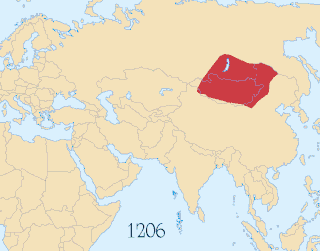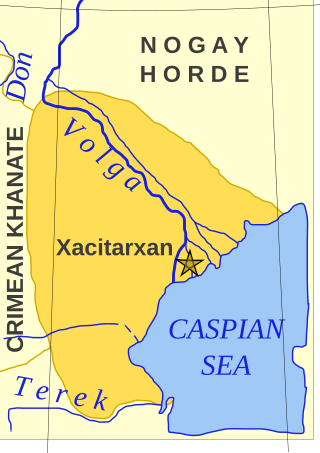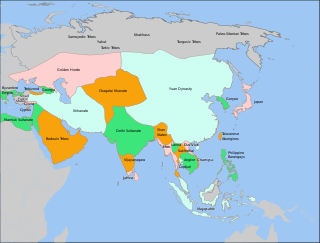Related Research Articles

The Golden Horde, self-designated as Ulug Ulus, was originally a Mongol and later Turkicized khanate established in the 13th century and originating as the northwestern sector of the Mongol Empire. With the division of the Mongol Empire after 1259, it became a functionally separate khanate. It is also known as the Kipchak Khanate or as the Ulus of Jochi, and it replaced the earlier, less organized Cuman–Kipchak confederation.
Khan is a historic Mongolic and Türkic title originating among nomadic tribes in the Central and Eastern Eurasian Steppe to refer to king. It first appears among the Rouran and then the Göktürks as a variant of khagan and implied a subordinate ruler. In the Seljük Empire, it was the highest noble title, ranking above malik (king) and emir (prince). In the Mongol Empire it signified the ruler of a horde (ulus), while the ruler of all the Mongols was the khagan or great khan. The title subsequently declined in importance. During the Safavid and Qajar dynasty it was the title of an army general high noble rank who ruling a province, and in Mughal India it was a high noble rank restricted to courtiers. After the downfall of the Mughals it was used promiscuously and became a surname. Khan and its female forms occur in many personal names, generally without any nobiliary of political relevance, although it remains a common part of noble names as well.

The Mongol Empire of the 13th and 14th centuries was the largest contiguous empire in history. Originating in present-day Mongolia in East Asia, the Mongol Empire at its height stretched from the Sea of Japan to parts of Eastern Europe, extending northward into parts of the Arctic; eastward and southward into parts of the Indian subcontinent, attempted invasions of Southeast Asia, and conquered the Iranian Plateau; and westward as far as the Levant and the Carpathian Mountains.

The Ilkhanate or Il-khanate, ruled by the Il-Khans or Ilkhanids, and known to the Mongols as Hülegü Ulus, was a khanate founded by Turco-Mongol conquerors from the southwestern sector of the Mongol Empire. The Ilkhanid realm was officially known as the Land of Iran or simply Iran. It was established after Hülegü, the son of Tolui and grandson of Genghis Khan, inherited the West Asian part of the Mongol Empire after his brother Möngke Khan died in 1259.

The Pax Mongolica, less often known as Pax Tatarica, is a historiographical term modeled after the original phrase Pax Romana which describes the stabilizing effects of the conquests of the Mongol Empire on the social, cultural and economic life of the inhabitants of the vast Eurasian territory that the Mongols conquered in the 13th and 14th centuries. The term is used to describe the eased communication and commerce the unified administration helped to create and the period of relative peace that followed the Mongols' vast and violent conquests.

Sultan Giyasuddin Muhammad Uzbek Khan, better known as Uzbeg, Uzbek or Ozbeg (1282–1341), was the longest-reigning khan of the Golden Horde (1313–1341), under whose rule the state reached its zenith. He was succeeded by his son Tini Beg. He was the son of Toghrilcha and grandson of Mengu-Timur, who had been khan of the Golden Horde from 1267 to 1280.

The Khanate of Astrakhan was a Tatar rump state of the Golden Horde. The khanate existed in the 15th and 16th centuries in the area adjacent to the mouth of the Volga river, around the modern city of Astrakhan. Its khans claimed patrilineal descent from Toqa Temür, the thirteenth son of Jochi and grandson of Genghis Khan.

Berke Khan was a grandson of Genghis Khan from his son Jochi and a Mongol military commander and ruler of the Golden Horde who effectively consolidated the power of the Blue Horde and White Horde from 1257 to 1266. He succeeded his brother Batu Khan of the Blue Horde (West), and was responsible for the first official establishment of Islam in a khanate of the Mongol Empire. Following the Sack of Baghdad by Hulagu Khan, his cousin and head of the Mongol Ilkhanate based in Persia, he allied with the Egyptian Mamluks against Hulagu. Berke also supported Ariq Böke against Kublai in the Toluid Civil War, but did not intervene militarily in the war because he was occupied in his own war against Hulagu and the Ilkhanate.

The Turco-Mongol or Turko-Mongol tradition was an ethnocultural synthesis that arose in Asia during the 14th century among the ruling elites of the Golden Horde and the Chagatai Khanate. The ruling Mongol elites of these khanates eventually assimilated into the Turkic populations that they conquered and ruled over, thus becoming known as Turco-Mongols. These elites gradually adopted Islam, as well as Turkic languages, while retaining Mongol political and legal institutions.
Edigu was a Mongol Muslim emir of the White Horde who founded a new political entity, which came to be known as the Nogai Horde.

The Berke–Hulagu war was fought between two Mongol leaders, Berke Khan of the Golden Horde and Hulagu Khan of the Ilkhanate. It was fought mostly in the Caucasus Mountains area in the 1260s after the destruction of Baghdad in 1258. The war overlaps with the Toluid Civil War in the Mongol Empire between two members of the Tolui family line, Kublai Khan and Ariq Böke, who both claimed the title of Great Khan (Khagan). Kublai allied with Hulagu, while Ariq Böke sided with Berke. Hulagu headed to Mongolia for the election of a new Khagan to succeed Möngke Khan, but the loss of the Battle of Ain Jalut to the Mamluks forced him to withdraw back to the Middle East. The Mamluk victory emboldened Berke to invade the Ilkhanate. The Berke–Hulagu war and the Toluid Civil War as well as the subsequent Kaidu–Kublai war marked a key moment in the fragmentation of the Mongol empire after the death of Möngke, the fourth Khan of the Mongol Empire.

Islam in Mongolia is practiced by approximately 3 to 5% of the population. It is practised by the ethnic Kazakhs of Bayan-Ölgii Province and Khovd Province aimag in western Mongolia. In addition, a number of small Kazakh communities can be found in various cities and towns spread throughout the country. Islam is also practiced by the smaller communities of Khotons and Uyghurs.

In modern times the Mongols are primarily Tibetan Buddhists, but in previous eras, especially during the time of the Mongol empire, they were primarily shamanist, and had a substantial minority of Christians, many of whom were in positions of considerable power. Overall, Mongols were highly tolerant of most religions, and typically sponsored several at the same time. Many Mongols had been proselytized by the Church of the East since about the seventh century, and some tribes' primary religion was Christian. In the time of Genghis Khan, his sons took Christian wives of the Keraites, and under the rule of Genghis Khan's grandson, Möngke Khan, the primary religious influence was Christian.

Maria Palaiologina was the daughter of the Byzantine Emperor Michael VIII Palaiologos who became the wife of the Mongol ruler Abaqa Khan, and an influential Christian leader among the Mongols. After Abaqa's death she became the leader of a Monastery in Constantinople which was popularly named after her as Saint Mary of the Mongols. Her monastic name was Melanie.

Tuda Mengu, also known as Tode Mongke and Tudamongke, was the khan of the Golden Horde, a division of the Mongol Empire, from 1280 until his death in 1287.
The Sufid dynasty was a Turkic dynasty of Mongolic origin that ruled in Khwarazm within the realm of the Golden Horde in the Amu Darya river delta. Although the dynasty's independence was short-lived, its later members continued to rule Khwarezm intermittently as governors of the Timurid Empire until the takeover of Khwarezm by the Shaybanid Uzbeks in 1505. Unlike earlier dynasties that ruled from Khwarezm, the Sufids never used the title Khwarazmshah.

Islamic missionary work or dawah means to "invite" to Islam. After the death of the Islamic prophet Muhammad, from the 7th century onwards, Islam spread rapidly from the Arabian Peninsula to the rest of the world through either trade and exploration or Muslim conquests.

The Mongols were highly tolerant of most religions during the early Mongol Empire, and typically sponsored several at the same time. At the time of Genghis Khan in the 13th century, virtually every religion had found converts, from Buddhism to Eastern Christianity and Manichaeanism to Islam. To avoid strife, Genghis Khan set up an institution that ensured complete religious freedom, though he himself was a Tengrist. Under his administration, all religious leaders were exempt from taxation, and from public service. Mongol emperors were known for organizing competitions of religious debates among clerics, and these would draw large audiences.
The spread of Islam spans almost 1,400 years. The early Muslim conquests that occurred following the death of Muhammad in 632 CE led to the creation of the caliphates, expanding over a vast geographical area; conversion to Islam was boosted by Arab Muslim forces expanding over vast territories and building imperial structures over time. Most of the significant expansion occurred during the reign of the rāshidūn ("rightly-guided") caliphs from 632 to 661 CE, which were the first four successors of Muhammad. These early caliphates, coupled with Muslim economics and trading, the Islamic Golden Age, and the age of the Islamic gunpowder empires, resulted in Islam's spread outwards from Mecca towards the Indian, Atlantic, and Pacific Oceans and the creation of the Muslim world. The Islamic conquests, which culminated in the Arab empire being established across three continents, enriched the Muslim world, achieving the economic preconditions for the emergence of this institution owing to the emphasis attached to Islamic teachings. Trade played an important role in the spread of Islam in some parts of the world, such as Indonesia. During the early centuries of Islamic rule, conversions in the Middle East were mainly individual or small-scale. While mass conversions were favored for spreading Islam beyond Muslim lands, policies within Muslim territories typically aimed for individual conversions to weaken non-Muslim communities. However, there were exceptions, like the forced mass conversion of the Samaritans.

The Timurid conquests and invasions started in the seventh decade of the 14th century with Timur's control over Chagatai Khanate and ended at the start of the 15th century with the death of Timur. Due to the sheer scale of Timur's wars, and the fact that he was generally undefeated in battle, he has been regarded as one of the most successful military commanders of all time. These wars resulted in the supremacy of Timur over Central Asia, Persia, the Caucasus, the Levant, and parts of South Asia and Eastern Europe, and also the formation of the short-lived Timurid Empire.
References
- ↑ The preaching of Islam: a history of the propagation of the Muslim faith By Sir Thomas Walker Arnold, pg. 197
- ↑ Devin De Weese, Devin A, ( DeWeese. "Islamization and Native Religion in the Golden Horde", Penn State Press, 1 September 1994, ISBN 0-271-01073-8 pg.3
- ↑ Vásáry, p.71
- ↑ Asian Mythologies, By Yves Bonnefoy, Wendy Doniger, Gerald Honigsblum, pg. 337
- ↑ Medieval Russia, 980-1584: 980-1584, By Janet Martin, by 171
- ↑ David Myatt: From Neo-Nazi to Muslim Archived August 25, 2009, at the Wayback Machine
- ↑ The fire, the star and the cross minority religions in medieval and early modern Iran, by Aptin Khanbaghi, pg. 69-70
- ↑ The Biographical Dictionary of the Society for the Diffusion of Useful, pg. 226
- ↑ Learning to Love Africa, By Monique Maddy, pg. 156
- ↑ Wars of imperial conquest in Africa, 1830-1914, By Bruce Vandervort, pg. 128
- ↑ Society and Culture in the Early Modern Middle East By Andrew J. Newman, University of Edinburgh, pg. 30